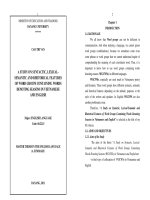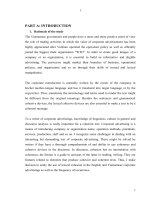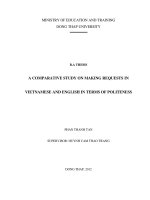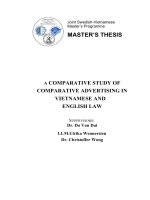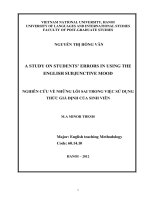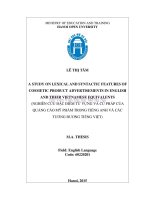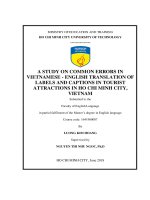A STUDY ON LEXICAL COHESION IN VIETNAMESE AND ENGLISH CORPORATE ADVERTISINGS
Bạn đang xem bản rút gọn của tài liệu. Xem và tải ngay bản đầy đủ của tài liệu tại đây (253.27 KB, 41 trang )
PART A: INTRODUCTION
1. Rationale of the study
The Vietnamese government and people have a more and more positive point of view
the role of trading activities in which the value of corporate advertisement has been
highly appreciated after Vietnam operated the open-door policy as well as officially
joined the biggest trade organization “WTO”. In order to create good images of a
company or an organization, it is essential to build an informative and eligible
advertising. The purveyors might market their branches of business, operational
policies, and organization and so on through their skills of textual and lexical
manipulation.
The corporate introduction is normally written by the owner of the company in
his/her mother-tongue language and has it translated into target language or by the
copywriter. Thus, sometimes the terminology and terms used to render the text might
be different from the original meanings. Besides the sentences and grammatical
cohesive devices, the lexical cohesive devices are also essential to make a text to be a
coherent message.
To a writer of corporate advertisings, knowledge of linguistics, culture in general and
discourse analysis is really important for a coherent text. Corporate advertising is a
means of introducing company or organization name, operation methods, potentials,
services, production, staff and so on. I recognize some challenges in dealing with an
interesting but demanding text of corporate advertising. These might be solved by
writers if they have a thorough comprehension of and ability to use coherence and
cohesive devices in the discourse. In discourse, cohesion has an interrelation with
coherence; the former is a guide to and part of the latter in reading, writing. They are
features related to elements that produce cohesive and coherent texts. Thus, I make
decision to study the use of lexical cohesion in the English and Vietnamese corporate
advertisings as well as the frequency of occurrence.
1
1
2. Aims of the study
This thesis aims to:
- give a systematic and comprehensive description of lexical cohesion features in
English
- figure out how these devices are used in texts
- make comparative analysis of lexical cohesion between English and Vietnamese
corporate advertisements to help copywriters and readers surmount difficulties
in using and understanding the lexical cohesive devices.
3. Scope of the study
Within the framework of a minor M. A thesis, we only study on lexical cohesion in the
corporate advertisement texts in English and Vietnamese taken from the only sources
of websites that introduce companies or organizations. The sample includes 3 texts in
English and 3 texts in Vietnamese used as written discourses.
4. Methods of the study
The methods of description, analysis and statistic in linguistics are used in this study.
The data are collected by pointing out the frequency of occurrence of lexical cohesive
devices used in the written discourse of corporate advertisements. The investigation
will lead to the implication of better methods of writing corporate advertisements using
lexical cohesive devices.
5. Design of the study
This minor thesis consists of three parts as follows:
Part A: Introduction
Part B: Development
There are three chapters in this part
Chapter 1 deals with theoretical background of the research with three main sections
like: discourse and discourse analysis, cohesion & coherence and lexical cohesion
Chapter 2 presents specific features of advertisement in general and corporate
advertisements in particular
2
2
Chapter 3 gives comparison of lexical cohesion in English and Vietnamese corporate
advertisements
Part C: Conclusion
In this part, the author summarizes the findings and giving suggestions for further
development in writing corporate advertisements.
3
3
PART B: DEVELOPMENT
CHAPTER I: THEORETICAL BACKGROUND
This chapter aims at dealing with theoretical framework of investigation such as
concepts of discourse, cohesion and coherence, cohesive devices, register and genre in
discourse analysis which are relevant to the purpose of this study, as well as the
definition and properties of advertisement in general and corporate advertisement in
particular.
1. Discourse and discourse analysis
1.1. The concepts of discourse
There are different ways of understanding and defining discourse. Halliday (1985)
defines “Discourse is a multidimensional process”. According to Crystal (1992)
discourse is seen as “a continuous stretch of language larger than a sentence, often
constituting a coherent unit such as a sermon, argument, joke, or narrative”. Cook
(1989) has a similar perspective of discourse; he considers discourse as “stretches of
language perceived to be meaningful, unified, and purposive”. In other words, as
Brown and Yule state, discourse is language material, either spoken or written, in
actual uses by speakers (and writters) of the language.
1.2. Text and Discourse
It is still in vagueness to define whether or not discourse and text are of two separate
entities and some linguists are trying to set them apart. According to Widdowson
(1979) text is sentences in combination whereas discourse is the use of sentence for
communication.
For some linguists, discourse is different from text. According to Cook (1989:158) text
is “ a stretch of language interpreted formally, without context”. However, Brown and
Yule (1983:6) argue that text is the representation of discourse and the verbal record
of a communicative act.
4
4
Actually, it is not easy to make a clear-cut distinction between “text” and “discourse”.
The concepts of discourse and text defined by Halliday (1985: 290) maybe the most
comprehensive. He states that “discourse” itself is a process and the term “text” is
usually taken as referring to the product. And obviously, cohesion and coherence are
typical of text as a language unit.
1.3. Spoken and written discourse
Talking and writing represent different modes of expressing linguistics meanings. As
stated by Halliday (1985) “Speaking does not show clearly sentence and paragraph
boundaries or signal the move into direct quotation while writing leaves out the
prosodic and paralinguistic contribution”. While written discourse comprises complete
sentences with subordination, rich lexis and frequent modifications via adjectives and
adverbs, spoken contains incomplete sentences. Although spoken and written
discourses share the communicative functions, they serve various functions. The
former is concerned with interact ional use and the latter with the transactional use
(Brown and Yule, 1983: 13)
By comparison, writing language is under no temporal, spatial pressure. The writer has
time to choose lexical items, check words and structures to make necessary correction
which is primarily concerned with the transactional use. Spoken language, as stated by
Brown and Yule (1983), is the kind of language which is produced under some
temporal, spatial pressure with the speaker’s monitoring of what it is that he has just
said, determining his current phrase and simultaneously planning his next utterance and
which is primarily concerned with the interactional use.
There are three prominent features that can apply to distinguish written and spoken
discourse.
1. Density: the density is the information volume presented. Evidently, written
language is dense while spoken language is sparse.
5
5
2. Complexity of grammar: in spoken language grammar is not so important, but
information. For written language, it is important to maintain enough
information, appropriate grammatical structures as well as rational organization
of sentences.
3. Grammatical metaphor: Written language presents rather few different verbs,
whereas spoken language uses more verbs.
These above characteristics are inherent in spoken and written language in whatever
types of discourse. Written texts can be read out and heard such as letters, stories,
novels, contracts, reports, speeches. Moreover, spoken discourse such as lectures,
lessons, interviews, conversations and so on can also be reserved in the form of writing.
2. Context in discourse analysis
2.1. The notion of context
As premise, we should take a short excursion into the history of the notion of context.
Halliday and Hasan draw their concept of context from Bronislaw Malinowski's
principle of describing the environment and culture along with the text to analyze.
Malinowski, himself being an anthropologist in the 1920s, added various information
to his reports on the language of the Trobriand islanders, which included as much
cultural background as possible (context of culture), and the immediate environment in
which the text was produced (context of situation). He encountered basic difficulties
when translating pragmatic conversations of the Trobrianders into English, but later on
realized that even so called "civilized" language, mostly used for abstraction, could not
be separated from its cultural and immediate surroundings if it had to be understood
and rendered intelligibly. Based on this early framework of context, more and more
features determining the production and reception of texts were defined and added,
from Firth's 'nonverbal actions', 'effects', and 'objects and events' surrounding the text,
to Hymes' 'intent', 'key', 'medium' and 'genre', and normative principles of the text.
According to Halliday then, all these features are indebted to the complexity of modern
society and communication itself, but they enable us to predict what is going to happen
6
6
within "the framework of something that we knew was going to happen". The success
of every act of communication thus is based on our predatory interpretation of the
cultural and situational context. The situational context of our text could be
characterized as well organized and highly predictable. In general, there are two main
types of context.
2.2. Context of situation
Context of situation is an integral concept of discourse analysis. According to Eggins
(1994:30), context of situation is usually discussed under three variables: what is talked
about, what the relationship between the communicators is; what role the language
plays. Other linguists have the same opinion that in order to understand thoroughly
what someone says or writes. It is necessary to know the context of situation like
Nunan (1983).
2.3. Context of culture
Besides the language and context of situation we need to pay attention to the context of
culture. As stated by Malinowski (1923) “if you are not a member of the culture, you
cannot understand what is meant”. To recognize the text as meaningful, the readers or
hearers need to refer the text to a cultural context. It is important to know the culture of
the given language in interpreting and understanding the given messages.
3. Cohesion & Coherence
3.1. Cohesion vs. Coherence
The concept of cohesion refers to relations of meaning that exist within the text, and
that defines it as a text. Cohesion occurs where the interpretation of some element in
the discourse dependent on that of another.
Cohesion is the network of lexical, grammatical, and other relations which link various
parts of a text. These relations or ties organize and, to some extent, create a text, for
instance, by requiring the reader to interpret words and expressions by reference to
other words and expressions in the surrounding sentences and paragraphs. Cohesion is
7
7
a surface relation and it connects together the actual words and expressions that we can
see or hear.
Halliday and Hasan (1986) identify five main cohesive devices in English: reference,
substitution, ellipsis, conjunction, and lexical cohesion.
E.g. American Life Inc. pays the mortgage on each property from its own funds
until the mortgage is paid in full. The Company’s principals have made personal
guarantees covering all debt and no debt is cross-collateralized among the
properties and partnerships.
Reading this example, we can understand that there is a link between ‘American Life
Inc.’ and ‘the Company’’.
Coherence, on the other hand, is defined as the relationships of various ideas in a text
that are linked together to create a meaningful discourse. According to Nunan (1993)
coherence is “the feeling that sequences of sentences or utterances seems to hang
together and make sense. In short, coherence means the relationships that link the
meanings of utterances in a discourse or of the sentences in a text. These links may be
based on the speakers’ shared knowledge.
E.g. The aviation business includes handling aircrafts and passengers, offering
security check, services of security guard, fire fighting and other ground
services.
In the above example, there is a conceptual relationship among the aviation business
and other terms in the text.
Though cohesion and coherence, in essence, is different from each other, they are
closely linked together. They represent the very essential elements that make a text or
discourse coherent and that make coherent text or discourse different from random
sentences or utterances. Cohesion is mainly used to embody coherence by a system of
8
8
cohesive devices. Accordingly, cohesion and coherence help consolidate the text as a
complete and unified linguistics unit beyond the largest syntactic unit of sentence.
3.2. Main principles of cohesion
Halliday & Hasan (1976) as well as other linguists assume that cohesion is
expressed partly through the grammar and partly through the vocabulary.
These cohesive devices are closely connected to create a coherent text.
Grammatical cohesion Lexical cohesion
Reference Reiteration
Exophoric reference Repetition
Endophoric reference Synonym/near-synonym
Substitution Antonym
Nominal substitution Super-ordinate
Verbal substitution General words
Clausal substitution
Collocatio
n
Ellipsis Adjective + noun
Nominal ellipsis Quantifier + noun
Verbal ellipsis Verb + noun
Clausal ellipsis Noun + verb
Conjunction Noun + noun
Additive Preposition + noun
Adversative Noun + preposition
Clausal Adverb + verb
Temporal Verb + verb
Others Verb + preposition
Verb + adverb
Adverb + adjective
Adjective + preposition
3.2.1. Grammatical Cohesion
We can see that a coherent text is a sequence of sentences or utterances which seem “to
be linked” together containing words or phrases that enable the writer or speaker to
establish boundaries across sentence or utterance and help sentences to be tied together.
They are considered as cohesive devices.
9
9
Structure in text is provided by grammar therefore cohesion is considered to be outside
of the structure. Cohesion refers to the “non-structural text-forming relations” (Halliday
and Hasan 1976: 7). The concept of cohesion in text is related to semantic ties or
“relations of meanings that exist within the text, and that define it as a text” (ibid: 4).
within text, if a previously mentioned item is referred to again and is dependent upon
another element, it is considered a tie. Without semantic ties, sentences or utterances
would seem to lack any type of relationship to each other and might not be considered
text. Halliday and Hasan (ibid: 4) refer to this interstitial link as “the presupposing”
and “the presupposed”. Using the authors’ example, “Wash and core six cooking
apples. Put them into a reproof dish.” The word “them” presupposes “apples” and
provides a semantic tie between the two sentences, thus creating cohesion. Cohesion
creates interdependency in text.
a. Referencing
Referencing functions to retrieve presupposed information in text and must be
identifiable for it to be considered as cohesive. In written text, referencing indicates
how the writer introduces participants and keeps track of them throughout the text.
(Eggins 1994: 95) There are three general types of referencing: homophonic
referencing, which refers to shared information through the context of culture,
exophoric referencing, which refers to information from the immediate context of
situation, and endophoric referencing, which refers to information that can be
“retrieved” from within the text. It is this endophoric referencing which is the focus of
cohesion theory. Endophoric referencing can be divided into three areas: anaphoric,
cataphoric, and esphoric. Anaphoric refers to any reference that “points backwards”
to previously mentioned information in text. Cataphoric refers to any reference that
“points forward” to information that will be presented later in the text. Esphoric refers
to any reference within the same nominal group or phrase which follows the
presupposed item. For cohesion purposes, anaphoric referencing is the most relevant
as it “provides a link with a preceding portion of the text” (Halliday and Hasan 1976:
51); hence its most common usage.
10
10
Functionally speaking, there are three main types of cohesive references: personal,
demonstrative, and comparative. Personal reference keeps track of function through
the speech situation using noun pronouns like “he, him, she, her”, etc. and possessive
determiners like “mine, yours, his, hers”, etc. Demonstrative reference keeps track of
information through location using proximity references like “this, these, that, those,
here, there, then, and the”. Comparative reference keeps track of identity and similarity
through indirect references using adjectives like “same, equal, similar, and different,
else, better, more”, etc. and adverbs like “so, such, similarly, otherwise, so, more”,
etc. (ibid: 37–39).
b. Substitution and Ellipsis
While referencing functions to link semantic meanings within text, substitution and
ellipsis differ in that they operate as linguistic links at the lexico-grammatical level.
In Bloor and Bloor (1995: 96), substitution and ellipsis are used when “a speaker or
writer wishes to avoid the repetition of a lexical item and is able to draw on one of the
grammatical resources of the language to replace the item”. The three types of
classification for substitution and ellipsis: nominal, verbal and clausal, reflect its
grammatical function. When something in text is being substituted, it follows that the
substituted item maintains the same structural function as the presupposed item. In
nominal substitution, the most typical substitution words are “one and ones” that
substitute nouns. In verbal substitution, the most common substitute is the verb “do”
and is sometimes used in conjunction with “so” as in “do so” and substitute verb and
verb phrases. Halliday and Hasan (ibid: 125–126) point out that “do” often operates
with the reference items “it” and “that” but still have the main function as a verbal
substitute because of its grammatical role. In clausal substitution, an entire clause is
substituted and though it may seem to be similar to either nominal or verbal substitu-
tion, the difference is the presupposed anaphoric reference.
Though substitution and ellipsis are similar in their functions as the linguistic links for
cohesion, ellipsis differs in that it is “substitution by zero”. (ibid: 142). Ellipsis refers
to a presupposed anaphoric item although the reference is not through a “place-
11
11
marker” like in substitution. The presupposed item is understood through its structural
link. As it is a structural link, ellipsis operates through nominal, verbal and clausal
levels. Halliday and Hasan further classify ellipsis in systemic linguistic terminology
as deictic, numerative, epithet, classifier, and qualifier.
c. Conjunction
Conjunction, as described by Bloor and Bloor (1995: 98) acts as a “cohesive tie
between clauses or sections of text in such a way as to demonstrate a meaningful
pattern between them”, though Halliday and Hasan (ibid: 227) indicate that
“conjunctive relations are not tied to any particular sequence in the expression”.
Therefore, amongst the cohesion-forming devices within text, conjunction is the least
directly identifiable relation. Conjunction acts as a semantic cohesive tie within text
in four categories: additive, adversative, causal and temporal. Additive conjunction
acts to structurally coordinate or link by adding to the presupposed item and are
signaled through “and, also, too, furthermore, additionally”, etc. Additive conjunction
may also act to negate the presupposed item and is signaled by “nor, and Not, either,
neither”, etc. Adversative conjunctions act to indicate “contrary to expectation” (ibid:
250) and are signaled by “yet, though, only, but, in fact, rather”, etc. Causal
conjunction expresses “result, reason and purpose” and is signaled by “so, then, for,
because, for this reason, as a result, in this respect, etc” and adverbs: consequently,
accordingly. The last conjunctive category is temporal and links by signaling sequence
or time. Some sample temporal conjunctive signals are “then, next, after that, next day,
until then, at the same time, at this point”, etc.
3.2.2. Lexical Cohesion
Halliday & Hasan (1976) classify reiteration into four types: the same word, a
synonym/near-synonym, a super-ordinate, and a general word. For example, ‘a boy’
can be replaced in the following sentences with ‘the boy’ (the same word), ‘the lad’ (a
synonym/ near-synonym), ‘the child’ (a super-ordinate), and ‘the idiot’ (a general
word) (Halliday & Hasan 1976: 279-80). Meanwhile, they recognize collocation as an
important part of creating cohesion in connected text. Collocation refers to the semantic
12
12
and structural relation among words, which native speakers can use subconsciously for
comprehension or production of a text. They argue the case of collocation as follows:
The cohesive effect…depends not so much on any systematic relationship as on their
tendency to share the same lexical environment, to occur in COLLOCATION with one
another. In general, any two lexical items having similar patterns of collocation – that
is, tending to appear in similar context – will generate a cohesive force if they occur in
adjacent sentences. (Halliday & Hasan 1976:286)
A ‘cohesive force’ will produce a ‘cohesive tie’, which is the relationship between a
cohesive item and the item it presupposed in a text. It other words, collocational links
between lexical items create cohesion.
In response to Halliday & Hasan (1976)’s initiation of cohesion, other researchers have
discussed lexical cohesion. However, cohesion can be concluded as “the means by
which texts are linguistically connected” (Carter 1998: 80). It is significant to recognize
that lexical cohesion cannot exits without sentences., That is, cohesive words should be
discussed not only as the meaning relations which hold between items, but also as the
explicit expression of those meaning relations within a text. Ultimately, it is necessary
to consider cohesion as “what gives a text texture”. (Halliday & Hasan 1976”)
3.3. Aspects of coherence
Coherence is product of many different factors, which combine to make every
paragraph, every sentence, and every phrase contribute to the meaning of the whole
piece. Coherence in writing is much more difficult to sustain than coherent speech
simply because writers have no nonverbal clues to inform them if their message is clear
or not. Therefore, writers must make their patterns of coherence much more explicit
13
13
and much more carefully planned. In general, there are two factors contributing to the
coherence of discourse.
1.3.3.1 Topical coherence
Only discussing on a specific topic, can the writer or speaker create a coherent text.
E.g. The experience we have gained integrating our medicines management
solutions enables us to offer a range of quality healthcare solutions where
patient care is the driver. Our products and services have a proven track record
of successfully delivering improvements to the patient care process. We have
established a reputation amongst clinicians that is second to none.
It is clear that the central topic of the above sentences concerns with the patient care
solutions of a hospital. The words and phrases are closely related to each other. The
passage is coherent because we have a feeling that the text hangs together and makes
sense, and is not just a jumble of sentences. In general, the topical coherence is
considered as the first important aspect of coherence.
1.3.3.2 Logical coherence
Another important aspect of coherence is logical coherence because it helps the reader
have a thorough understanding of the text. Looking back at the example of the above
extract, it is apparent that all the sentences are logically connected. The first sentence
functions as a topic sentence introducing the competence and experience of a hospital
and followed with supportive sentences proving by the quality and success of the
operation as well as the staff.
It can be said that what makes the above extract different from random sentences is the
coherence achieved by means of logical coherence. Generally, in order to have clauses
and sentences of a text linked with each other, it is necessary to have cohesion and
coherence. What makes a text topically and logically coherent is achieved with the
usage of topical coherence and logical coherence.
14
14
CHAPTER II: SOME GENERAL FEATURES OF ENGLISH AND
VIETNAMESE ADVERTISEMENTS
1. Advertising
In the era of high technology, public media present a lot of advertisings that are so
familiar with readers that it is not normal to ask what advertisement is. Advertising is
15
15
around us and so popular that we hardly stop to think of its nature as a form of
discourse, as a system of language use. We hardly notice the advertisement of
corporate on newspaper, internet, but only read product advertisement, game shows
and so on. People consider it as nonsensical ads and they present unattractive
information.
Advertising is an important form of self-promotion, the consequence of marketing
strategies used by companies to communicate with their existing and potential
customers, advertising is a key element in the marketing and advertising expenditure
takes a rather big account of many companies’ budget.
The main target of advertising is to influence consumer’s behavior, stimulate them
towards action such as sales promotion, hire purchase, special offer. And for different
purposes, advertising can be defined in different ways:
As defined by Cook (1992), advertising is both a linguistic and social activity. It is one
of the complex social activities dependent on language as the medium through which
the activity is accomplished. An advertisement is defined as ‘a public notice designed
to spread information with a view to promoting the sales of marketable goods and
services’. Still, advertising is not just about the commercial promotion of branded
products, but can also encompass the idea of texts whose intention is ‘to enhance the
image of an individual, group, or organization’.
Sometimes, advertising is intended to inform, but more often, and more importantly, to
persuade and influence. It, moreover, not only influences any human society in which it
is widespread but also reflects certain aspects of that society’s.
Advertising is the collective term for public announcements designed to promote the
sale of specific commodities or services. It is to be distinguished from other activities
intended to persuade the public such as propaganda publicity and public relations.
16
16
Advertising techniques range in complexity from the publishing of straightforward
notices in the classified-advertising columns of newspapers to the concerted use of
newspapers magazines television radio direct mail and other communications media in
the course of a single advertising campaign. From its unsophisticated beginnings in
ancient times advertising has burgeoned into a worldwide industry.
Advertising goal is a specific communicative task and achievement level to be
accomplished with a specific audience in a specific period of time (Colly: 1997)
From the linguistic points of view, advertising is an activity of verbal communication
not only to present information but also to win the mind and heart of advertisement
receivers, the potential customers. As a result, advertisers benefit from this act.
Advertising whose purpose is to promote the image of a corporation rather than the sale of
a product or service; also called institutional advertising. This advertising is also used to
create public awareness of a corporation or to improve its reputation in the marketplace.
2. Corporate advertisements
A relatively minor but important form of advertising is corporate advertisement which
is designed solely to build prestige and public respect for particular business. Corporate
advertisements are sometimes called as “institutional advertisements” that introduce
business, culture and identity of a company or an organization. Different from
advertisements of name brand, the sale of a product or service, business to business and
public service, corporate advertisement gives potential customers an overview of the
enterprises operation, orientation, potentials, staff… or improve its reputation in the
market. Corporate advertisement is a major contributor toward the first impression
buyers will have of a company or organization and is a great opportunity to gain their
trust.
When writing a corporate advertisement it is important to remember that its length
must be between 400 and 4,000 characters. With this in mind, it makes good sense to
17
17
plan how the writer is going to structure the information and the presentation of the
text.
3. Structure of a corporate advertisement
Paragraph 1 - The introduction
The first paragraph is used to introduce a company including:
1. The year the company was established
2. Company’s location
3. What products/services the company offers
4. Any Foreign investment that the company may have
Simply state the year in which the company was established. As for the company’s
location, the city and state/province are sufficient so it is not necessary to write a
historical overview of the surrounding area. The reader wants to read about the
company, not what its location looks like.
Paragraph 2 - What the company do
After introducing the company in paragraph one, the second paragraph would be an
ideal place to establish:
1. Product range/services offered
2. Machinery and technology used
3. Production experience
4. Number of staff (and foreign language speakers if the company has them)
5. How orders are handled
6. Shared significant achievements that would be meaningful to buyers
18
18
When introducing products, avoid lengthy descriptions as they belong in the product
description section. Certain industries will be interested in knowing what machinery
and technology the company uses and the production experience as well.
Stating the number of people that the company employs will give the readership an
indication of the company’s size. If the company does employ speakers of foreign
languages, make sure that it is clear as potential buyers will feel confident that they will
be understood when they contact the company.
Making buyers aware of significant achievements that the company has made is
another effective way to differentiate the company from other competitors.
Paragraph 3 – Quality certificate (QC)
Quality certifications (such as ISO) allow for an increased level of trust and mentioning
them in the company introduction can only benefit it. The company may also wish to
inform buyers of the quality control procedures that it has in place and whether the use
or welcome third parties approved by buyers to handle QC operations. Additionally,
adding the company monthly output volume, countries/regions serviced and any major
clients that the company have will also build credibility with buyers. It is important to
keep in mind that awards or certifications that are specific to the city or area only will
be meaningless to readers and omit such certificates to save the reader from confusion.
Paragraph 4 - The closing
Many companies use the final paragraph of their company introductions to state their
corporate values and invite buyers to contact them.
Let us look at the following specific example for the above sample
Innovation First Notice was founded in 1993 with the vision of improving the customer
service of insurance carriers, third-party administrators, and self-insureds—while
simultaneously cutting their costs.
19
19
The initial focus was on First Notice of Loss (FNOL) reports. Insurance companies
then, like today, were not in the business of capturing information or running call
centers. Loss reports came in from everywhere: agencies; branches; regional call
centers; etc. Containing inconsistent and incomplete data, these handwritten forms,
faxes and electronic files took days moving between company offices/systems and often
had to be re-entered along the way.
The need was just as clear in the call centers. Policyholders calling in by phone
experienced long hold times and often couldn’t get through at all during peak times
and CAT (catastrophe) situations. Incomplete data capture led to frequent callbacks.
“Business-hours only” added to the frustration.
Enter Innovation First Notice. Our dedicated professionals, redundant call centers and
flexible technology platform have eliminated these inefficiencies in information intake,
yielding higher customer satisfaction, faster processing times and substantially lower
costs. We offer our clients:
• Three call centers providing 24x7, after-hours and overflow service so
a client’s customers always get through.
• CSRs (customer service representatives) highly skilled in sensitive
insurance and healthcare programs to expertly guide callers through
times of need.
• Customizable intake software that adapts to the most complex business
rules and integrates directly with client systems.
• The experience gained from 14 years of service handling millions of
information transfers.
The original vision remains: improve service and cut costs.
Throughout its history, Innovation First Notice has stayed true to this vision, becoming
the premier provider of outsourced customer service solutions to the insurance and
healthcare markets. Over 100 top companies now trust First Notice to seamlessly
20
20
connect them with their customers in times of need. And while our focus is still claim
reporting, our flexible technology and call center expertise allow us to creatively build
and deliver services for a wide range of applications.
4. Context in English and Vietnamese corporate advertisements
There is no doubt that context plays a major part in comprehension of a text meaning as
well as in discourse analysis.
a. Field
The field of discourse relates to the subject matter of the text (advertisement, law, trade
and so on), to the persons and things involved, to the nature of the activities, to the
qualities of the entities involved and to the circumstances of the activities.
The corporate advertisements in English and Vietnamese share the same purpose of
providing essential information about the operation and business of a company in detail
and easy to remember.
b. Mode
Mode presents the medium and channel of the text. The two basic modes are spoken
(monologue, conversation) and written (newspaper articles, reference book). In
addition, written mode and spoken mode can be interchangeable for example spoken
mode can be interpreted into written mode (e.g. a dialogue in an article of a
newspaper), a written mode can be presented in spoken mode (e.g. a novel or drama is
spoken as a play).
Language used in the corporate advertisements must be concrete and informative so
that the reader of different English levels can understand.
c. Tenor
21
21
Tenor is divided into personal tenor and functional tenor. Personal tenor is concerned
with the social roles of participants together with their status relationship and
personalities; it thus handles the degree of formality, familiarity and technicality of
linguistic exchanges whereas functional tenor is concerned with determining the social
function or role of utterance, identifying the purpose of which the language is used.
Considering English and Vietnamese corporate advertisements, we can recognize that
the two discourses are written by company owners or copywriters who have a deep
comprehension of the company structure. However, the target readership can be those
who get information on purpose or by chance provided that they find it interesting and
eager to read more.
CHAPTER 3: A COMPARATIVE STUDY ON LEXICAL
COHESIVE DEVICES IN ENGLISH AND VIETNAMESE
CORPORATE ADVERTISEMENTS
1. General picture of lexical cohesive devices in Corporate advertisements
Understanding comprehensively the usage and functions of the lexical cohesive devices
will help the writer to create effectively coherent texts in general and corporate
advertisements in particular. While topical and logical cohesion of a text expresses a
coherent text in an overall level, cohesive devices point out they are parts of the text
22
22
and combine together to develop the structure of a text in detail. Within the limit of a
minor thesis, I only focus on lexical cohesive devices which have a great contribution
to the creation of the cohesive and coherent text with precision, unambiguity and
tightness.
The corporate advertisements are extracted from websites of companies and
organizations. These texts are written in English and Vietnamese. In the field of
corporate advertisement, due to the shortage of time, we take 3 texts in English and 3
texts in Vietnamese as written discourse of corporate advertisement from which we
analyze the application of lexical cohesion in writing.
The careful investigation into the corporate advertisements in English and Vietnamese
brings into some prominent features in using lexical cohesive devices involving:
Lexical reiteration (repetition, synonymy, antonymy, super-ordinate) and collocation.
After carefully investigating the written discourse of corporate advertisements, we can
present an overall picture of the occurrence of lexical cohesive devices in Table 3.1
below:
Table 3.1. Times and frequency of occurences of lexical cohesive devices in English &
Vietnamese corporate advertisements
Number of text Lexical cohesive
devices
in English in Vietnamese
3 Repetition 92 (47%) 65 (46%)
3 Synonymy 17 (9%) 13 (9%)
3 Antonymy 10 (5%) 10 (7%)
3 Super-ordinate 11 (6%) 7 (5%)
3 Collocation 65 (33%) 47 (33%)
3 Total 195 (100%) 142 (100%)
23
23
The percentages of lexical cohesive devices’ contribution to the cohesion of English
CAs are presented in the pie-chart as follows:
Figure 3.1 – Percentage of Lexical cohesive devices in English CAs
The percentages of each lexical cohesive device’ contribution to the overall cohesion of
English CAs are shown in the pie-chart below:
Figure 3.2 – Percentage of Lexical cohesive devices in Vietnamese CAs
It is clear that repetition accounts for large portion in comparison with other lexical
cohesive devices.
2. A detailed analysis of Lexical Cohesive Devices in English and Vietnamese
corporate advertisements
24
24
47%
9%
5%
6%
33%
Repetition
Synonym
Antonym
Super- ordinate
Collocat io n
Basically there is no basic difference in terms of nature of lexical cohesive devices
used in any genres or registers. They are items whichcommonly appeared in any
documents to create clarity and coherence. It is impossible to state that repetition only
specified in this document or other ones. Thus, the thesis will not go deeply into the
nature of these devices. We attach greater importance to showing examples to
demonstrate lexical cohesive devices in use. Later on, we will present statistical results
of frequency of lexical cohesive devices appeared in both English and Vietnamese
corporate advertisements basing on the analysis data.
2.1 Lexical reiteration
One thing that makes the text coherent is repeating important words or phrases.
According to Tran Ngoc Them (1985: 106) “Lexical reiteration is a form of lexical
cohesion in which the two cohesive items refer to the same entity and event”. As
defined by Halliday & Hasan (1976: 319) “Reiteration is the repetition of a lexical
item, or the occurrence of a synonym of some kinds, in the context of reference; that is,
where the two occurrences, have the same reference. Typically, therefore, a reiterated
lexical item is accompanied by a reference item, usually “the” or a demonstrative. The
complex consisting of “the” plus reiterated lexical item is therefore cohesive by
reference. But since reiteration is itself cohesive in its own right, as shown by the fact
that cohesion takes place even where there is no referential relation”. A text is
coherent, it means that all of its sentences refer to the same object, certain events;
therefore, lexical repetition represents the only device to realize such texts. Reiteration
as a form involving the repetition of lexical items, the use of a general word of a
preceding item and the number of thing in between – the use of synonym, near
synonym, or super-ordinate. Let us analyze elements of reiteration in turn to have a
clear picture of their frequency as well as cohesive functions in the corporate
advertisements.
2.1.1 Repetition
25
25

